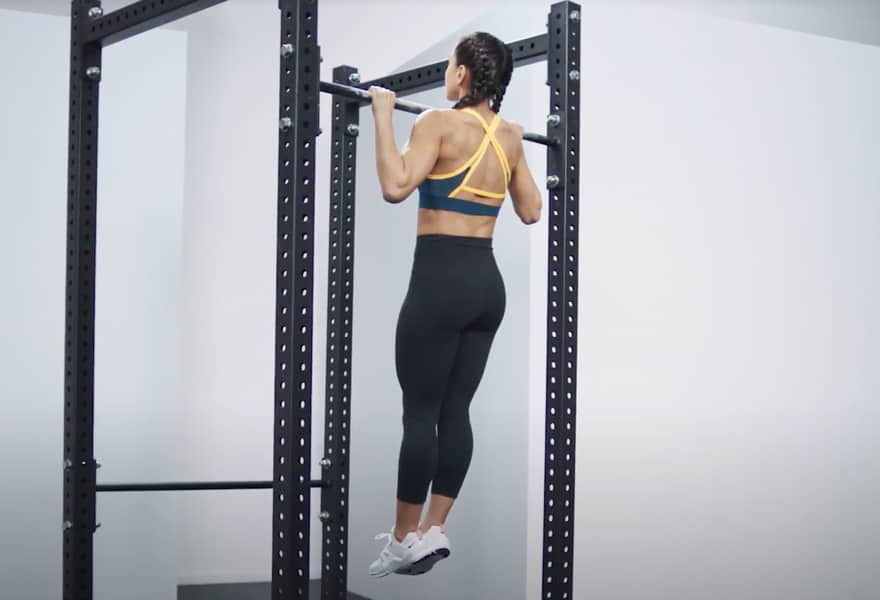How—and Why—to Do a Pull-Up
Coaching
By Flor Beckmann
How and why to check your form for ultimate results.
Nike Master Trainer, Flor Beckmann, shows you how and why you need to add the perfect pull-up to your workout routine. Take on all of her tips to start reaping the results.
Pull-ups might seem like a show-off's move. (Can you think of a greater quintessential display of strength? Yeah, didn't think so.) But they get their street cred for a good reason: They're an incredibly challenging and effective exercise that trains your entire upper body better than practically any other bodyweight exercise.
Here, Nike Master Trainer Flor Beckmann breaks down the pull-up's benefits and step-by-step instructions so you can show off your strength—whether it's your first rep or your much-improved hundredth.
Muscles You'll Work
Pull-ups primarily light up your lats, those wing-shaped muscles that run the length of your back, stretching to your sides and hips. But they also blast your arms (biceps, forearms and triceps), shoulders, chest, middle and upper back and all of the small muscles along your spine (erector spinae). You'll work your abs too, because your core needs to jump in to stabilise your body and help out your arms as you hoist yourself up.

Why You Should be Doing a Pull-Up
- Lifting your entire body weight isn't something you can replicate with any other exercise. You'll see the results of pull-ups in the form of a sculpted back, but you'll feel them even more: all of that upper-body strength will help you crush sports like rock climbing and swimming, plus make you more efficient in the gym.
- Because you're holding onto a bar throughout the entire exercise, you'll gradually increase your grip strength. A strong grip helps you perform more reps with heavier weights when you're lifting, and it's been linked to improved long-term health.
- Pull-ups strengthen the musculature around your shoulder joints and spine, which can help clean up your posture. Aside from the natural form boost, better posture can reduce back pain, especially if you're hunched over a computer all day.
- Pull-ups train your body to move as a unit. This fluidity will prepare you for sports-specific movements and everyday activities, such as lifting your bike onto the roof of your car in one fell swoop.
- The ability to do even one pull-up is a milestone achievement that requires serious strength. In other words, you'll feel like a badass with every single rep you add.
"Pull-ups train your body to move as a unit. This fluidity will prepare you for sports-specific movements and everyday activities, such as lifting your bike onto the roof of your car in one fell swoop".
Flor Beckmann

When to Do It
All you need is a pull-up bar, climbing frame or similarly stable overhead, horizontal contraption. Perform pull-ups after your warm-up, when your muscles have been activated but not fatigued, and pair them with pushing exercises, such as push-ups. To build strength, do between 2 and 5 sets of 2 to 4 reps, with plenty of recovery time in between. If hypertrophy (adding muscle) is your goal, do between 2 and 5 sets of 8 to 12 reps.
How to Do a Pull-Up
- Stand under a pull-up bar. Jump to grab the bar with an overhand grip slightly more than shoulder-width apart. Hang with arms and legs extended, to start.
- Pull your shoulder blades back and down as you engage your back, core and glutes. Pull yourself up until your chin clears the bar. As you do, think about pulling the bar to your chest. Keep your elbows close to your torso and no more than a natural arch in your lower back.
- Slowly lower your body to return to the starting position. That's 1 rep. Reset your shoulders between each rep, pulling them down your back.

Make It Easier
Try the assisted pull-up machine, which replicates the exercise but removes some of your body weight. Don't have one around? Tie a resistance band around the middle of a pull-up bar so the loop hangs low. Place a bench next to it so you can step one foot into the loop, then place your other foot on top of that one. With legs straight, hold onto the bar and begin your pull-up. If that's too easy, use a lighter resistance band (it provides less help) or place one knee in the loop.
You can also start with chin-ups. The mechanics are the same, except you grasp the bar with an underhand grip (palms facing you). This recruits your biceps more to complete the move.
Make It Harder
Once you've mastered the standard pull-up, you can add a weighted vest or try different variations, such as a super-narrow grip, which throws more work on your middle-back muscles instead of your lats, or pull-ups with leg lifts, which ups the challenge on your core. You could also slow down each rep to increase time under tension, ultimately building more strength and muscular endurance.
Train With Us
Tap into the ultimate training resource with the Nike Training Club App. With expertly designed workouts and holistic tips on nutrition, mindset, recovery and sleep, NTC has everything you need to perform your best.
Join Nike Training Club
Get access to our world-class experts and trainers for help staying active and healthy.

Join Nike Training Club
Get access to our world-class experts and trainers for help staying active and healthy.